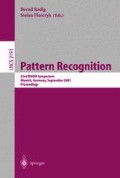Abstract
We demonstrate a method to automatically extract spatio-temporal descriptions of human faces from synchronized and calibrated multi-view sequences. The head is modeled by a time-varying multi-resolution subdivision surface that is fitted to the observed person using spatio-temporal multi-view stereo information, as well as contour constraints. The stereo data is utilized by computing the normalized correlation between corresponding spatio-temporal image trajectories of surface patches, while the contour information is determined using incremental background subtraction. We globally optimize the shape of the spatio-temporal surface in a coarse-to-fine manner using the multiresolution structure of the subdivision mesh. The method presented incorporates the available image information in a unified framework and automatically reconstructs accurate spatio-temporal representations of complex non-rigidly moving objects.
Access this chapter
Tax calculation will be finalised at checkout
Purchases are for personal use only
Preview
Unable to display preview. Download preview PDF.
References
I.A. Essa and A.P. Pentland. Coding, analysis, interpretation, and recognition of facial expressions. IEEE Trans. PAMI, 19:757–763, 1997.
O. Faugeras and R. Keriven. Complete dense stereovision using level set methods. In Proc. Europ. Conf. Computer Vision, pages 379–393, Freiburg, Germany, 1998.
P. Fua. Regularized bundle-adjustment to model heads from image sequences without calibration data. Int. Journal of Computer Vision, 38:153–171, 2000.
B. K. P. Horn. Robot Vision. McGraw Hill, New York, 1986.
Andreas Hubeli and Markus Gross. A survey of surface representations for geometric modeling. Technical Report 335, ETH Zürich, Institute of Scientific Computing, March 2000.
I.A. Kakadiaris and D. Metaxas. Three-dimensional human body model acquisition from multiple views. Int. Journal of Computer Vision, 30:191–218, 1998.
A. Laurentini. The visual hull concept for silhouette-based image understanding. IEEE Trans. PAMI, 16:150–162, 1994.
S. Malassiotis and M.G. Strintzis. Model-based joint motion and structure estimation from stereo images. Computer Vision and Image Understanding, 65:79–94, 1997.
C. Mandal, H. Qin, and B.C. Vemuri. Physics-based shape modeling and shape recovery using multiresolution subdivision surfaces. In Proc. of ACM SIGGRAPH, 1999.
R. Plänkers and P. Fua. Tracking and modeling people in video sequences. Int. Journal of Computer Vision, 2001. to appear.
P. Schröder and D. Zorin. Subdivision for modeling and animation. Siggraph 2000 Course Notes, 2000.
 Fig. 2. Results of 3D Structure and Motion Flow Estimation
Fig. 2. Results of 3D Structure and Motion Flow EstimationS. Seitz and C. Dyer. Photorealistic scene reconstruction by voxel coloring. Int. Journal of Computer Vision, 25, November 1999.
H. Spies, B. Jähne, and J.L. Barron. Regularised range flow. In Proc. Europ. Conf. Computer Vision, Dublin, Ireland, June 2000.
J. Stam. Evaluation of loop subdivision surfaces. SIGGRAPH’99 Course Notes, 1999.
G. Taubin. A signal processing approach to fair surface design. In Proc. of ACM SIGGRAPH, 1995.
S. Vedula, S. Baker, P. Rander, R. Collins, and T. Kanade. Three-dimensional scene flow. In Proc. Int. Conf. Computer Vision, Corfu,Greece, September 1999.
S. Vedula, S. Baker, S. Seitz, and T. Kanade. Shape and motion carving in 6d. In Proc. IEEE Conf. Computer Vision and Pattern Recognition, Head Island, South Carolina, USA, June 2000.
S. Vedula, P. Rander, H. Saito, and T. Kanade. Modeling, combining, and rendering dynamic real-world events from image sequences. In Proc. of Int. Conf. on Virtual Systems and Multimedia, Gifu, Japan, November 1998.
S. Weik. Passive full body scanner using shape from silhouettes. In Proc. Int. Conf. on Pattern Recognition, Barcelona, Spain, 2000.
Y. Zhang and C. Kambhamettu. Integrated 3d scene flow and structure recovery from multiview image sequences. In Proc. IEEE Conf. Computer Vision and Pattern Recognition, pages II:674–681, Hilton Head, 2000.
Author information
Authors and Affiliations
Editor information
Editors and Affiliations
Rights and permissions
Copyright information
© 2001 Springer-Verlag Berlin Heidelberg
About this paper
Cite this paper
Neumann, J., Aloimonos, Y. (2001). Spatio-temporal Analysis of Human Faces Using Multi-Resolution Subdivision Surfaces. In: Radig, B., Florczyk, S. (eds) Pattern Recognition. DAGM 2001. Lecture Notes in Computer Science, vol 2191. Springer, Berlin, Heidelberg. https://doi.org/10.1007/3-540-45404-7_9
Download citation
DOI: https://doi.org/10.1007/3-540-45404-7_9
Published:
Publisher Name: Springer, Berlin, Heidelberg
Print ISBN: 978-3-540-42596-0
Online ISBN: 978-3-540-45404-5
eBook Packages: Springer Book Archive


 Fig. 2. Results of 3D Structure and Motion Flow Estimation
Fig. 2. Results of 3D Structure and Motion Flow Estimation